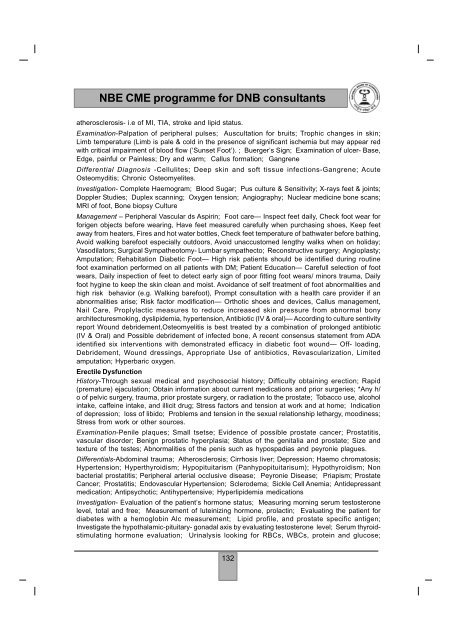NBE CME programme for DNB consultants - National Board Of ...
NBE CME programme for DNB consultants - National Board Of ...
NBE CME programme for DNB consultants - National Board Of ...
Create successful ePaper yourself
Turn your PDF publications into a flip-book with our unique Google optimized e-Paper software.
<strong>NBE</strong> <strong>CME</strong> <strong>programme</strong> <strong>for</strong> <strong>DNB</strong> <strong>consultants</strong>atherosclerosis- i.e of MI, TIA, stroke and lipid status.Examination-Palpation of peripheral pulses; Auscultation <strong>for</strong> bruits; Trophic changes in skin;Limb temperature (Limb is pale & cold in the presence of significant ischemia but may appear redwith critical impairment of blood flow (‘Sunset Foot’). ; Buerger’s Sign; Examination of ulcer- Base,Edge, painful or Painless; Dry and warm; Callus <strong>for</strong>mation; GangreneDifferential Diagnosis -Cellulites; Deep skin and soft tissue infections-Gangrene; AcuteOsteomyditis; Chronic Osteomyelites.Investigation- Complete Haemogram; Blood Sugar; Pus culture & Sensitivity; X-rays feet & joints;Doppler Studies; Duplex scanning; Oxygen tension; Angiography; Nuclear medicine bone scans;MRI of foot, Bone biopsy CultureManagement – Peripheral Vascular ds Aspirin; Foot care— Inspect feet daily, Check foot wear <strong>for</strong><strong>for</strong>igen objects be<strong>for</strong>e wearing, Have feet measured carefully when purchasing shoes, Keep feetaway from heaters, Fires and hot water bottles, Check feet temperature of bathwater be<strong>for</strong>e bathing,Avoid walking barefoot especially outdoors, Avoid unaccustomed lengthy walks when on holiday;Vasodilators; Surgical Sympatheotomy- Lumbar sympathecto; Reconstructive surgery; Angioplasty;Amputation; Rehabitation Diabetic Foot— High risk patients should be identified during routinefoot examination per<strong>for</strong>med on all patients with DM; Patient Education— Carefull selection of footwears, Daily inspection of feet to detect early sign of poor fitting foot wears/ minors trauma, Dailyfoot hygine to keep the skin clean and moist. Avoidance of self treatment of foot abnormalities andhigh risk behavior (e.g. Walking barefoot), Prompt consultation with a health care provider if anabnormalities arise; Risk factor modification— Orthotic shoes and devices, Callus management,Nail Care, Proplylactic measures to reduce increased skin pressure from abnormal bonyarchitecturesmoking, dyslipidemia, hypertension, Antibiotic (IV & oral)— According to culture sentivityreport Wound debridement,Osteomyelitis is best treated by a combination of prolonged antibiotic(IV & Oral) and Possible debridement of infected bone, A recent consensus statement from ADAidentified six interventions with demonstrated efficacy in diabetic foot wound— <strong>Of</strong>f- loading,Debridement, Wound dressings, Appropriate Use of antibiotics, Revascularization, Limitedamputation; Hyperbaric oxygen.Erectile DysfunctionHistory-Through sexual medical and psychosocial history; Difficulty obtaining erection; Rapid(premature) ejaculation; Obtain in<strong>for</strong>mation about current medications and prior surgeries; *Any h/o of pelvic surgery, trauma, prior prostate surgery, or radiation to the prostate; Tobacco use, alcoholintake, caffeine intake, and illicit drug; Stress factors and tension at work and at home; Indicationof depression; loss of libido; Problems and tension in the sexual relationship lethargy, moodiness;Stress from work or other sources.Examination-Penile plaques; Small tsetse; Evidence of possible prostate cancer; Prostatitis,vascular disorder; Benign prostatic hyperplasia; Status of the genitalia and prostate; Size andtexture of the testes; Abnormalities of the penis such as hypospadias and peyronie plagues.Differentials-Abdominal trauma; Atherosclerosis; Cirrhosis liver; Depression; Haemo chromatosis;Hypertension; Hyperthyroidism; Hypopituitarism (Panhypopituitarisum); Hypothyroidism; Nonbacterial prostatitis; Peripheral arterial occlusive disease; Peyronie Disease; Priapism; ProstateCancer; Prostatitis; Endovascular Hypertension; Sclerodema; Sickle Cell Anemia; Antidepressantmedication; Antipsychotic; Antihypertensive; Hyperlipidemia medicationsInvestigation- Evaluation of the patient’s hormone status; Measuring morning serum testosteronelevel, total and free; Measurement of luteinizing hormone, prolactin; Evaluating the patient <strong>for</strong>diabetes with a hemoglobin Alc measurement; Lipid profile, and prostate specific antigen;Investigate the hypothalamic-pituitary- gonadal axis by evaluating testosterone level; Serum thyroidstimulatinghormone evaluation; Urinalysis looking <strong>for</strong> RBCs, WBCs, protein and glucose;132
















